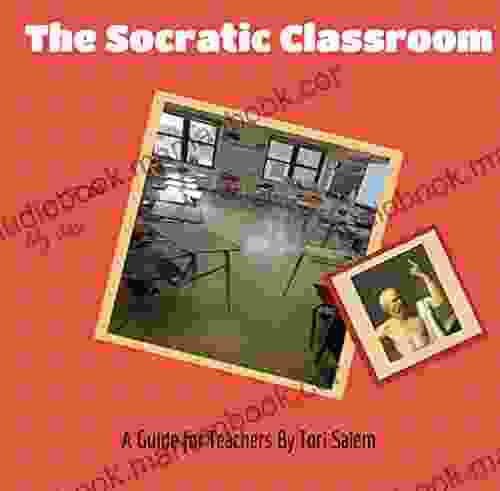The Socratic method is a centuries-old teaching technique that has been used to cultivate critical thinking, engage students, and foster deeper learning. Named after the ancient Greek philosopher Socrates, this method revolves around asking probing questions to encourage students to examine their beliefs, values, and assumptions. In recent years, there has been a resurgence of interest in the Socratic method, as educators seek more effective ways to promote student engagement and understanding.
This comprehensive guide provides teachers with everything they need to know about implementing the Socratic method in their classrooms. From the principles of Socratic questioning to practical strategies and lesson plans, this guide will equip teachers with the tools they need to create a dynamic and thought-provoking learning environment.
4 out of 5
| Language | : | English |
| File size | : | 1149 KB |
| Text-to-Speech | : | Enabled |
| Screen Reader | : | Supported |
| Enhanced typesetting | : | Enabled |
| Word Wise | : | Enabled |
| Print length | : | 12 pages |
| Lending | : | Enabled |
Understanding the Socratic Method
At its core, the Socratic method is a style of teaching that emphasizes questioning, critical thinking, and self-discovery. Rather than simply providing students with information, Socratic teachers guide students through a process of inquiry, helping them to develop their own understanding of complex concepts.
The following are the key principles of the Socratic method:
- Questioning: Socratic teachers ask a series of probing questions that challenge students' assumptions and encourage them to think critically about their beliefs and values.
- Dialectic: Socratic questioning is typically conducted in a dialogue format, with the teacher and students engaging in a back-and-forth exchange of ideas.
- Self-Discovery: The ultimate goal of the Socratic method is to help students discover truth and knowledge for themselves, rather than simply accepting the teacher's authority.
Benefits of the Socratic Method
The Socratic method offers a number of benefits for students, including:
- Critical Thinking Skills: Socratic questioning forces students to analyze information, identify biases, and evaluate arguments, developing their critical thinking abilities.
- Communication Skills: The dialogue format of Socratic questioning encourages students to articulate their ideas clearly and respectfully, improving their communication skills.
- Deeper Understanding: By actively engaging with the material and questioning their own beliefs, students develop a deeper understanding of complex concepts.
- Intellectual Curiosity: The Socratic method sparks intellectual curiosity and encourages students to explore new ideas and perspectives.
Implementing the Socratic Method
To effectively implement the Socratic method in the classroom, teachers should follow these steps:
- Create a Safe and Respectful Environment: Students need to feel comfortable sharing their ideas without fear of judgment or ridicule.
- Start with Open-Ended Questions: Begin by asking broad, open-ended questions that encourage students to think creatively and share their perspectives.
- Follow-Up Questions: Use follow-up questions to probe students' thinking, challenge their assumptions, and guide them towards deeper understanding.
- Use Facilitating Language: Use phrases such as "Can you explain your reasoning?" or "What evidence do you have to support your claim?" to encourage students to elaborate on their ideas.
- Facilitate Class Discussions: Encourage students to engage with each other's ideas and build on each other's thinking.
Lesson Plans and Activities
The following are a few lesson plans and activities that teachers can use to implement the Socratic method in their classrooms:
Lesson Plan: Socratic Seminar
A Socratic seminar is a structured discussion format that allows students to engage with complex texts and ideas in a collaborative setting.
Materials:
- A text or set of readings that students have prepared in advance
- A list of discussion questions
Procedure:
- Begin by introducing the text or readings and asking students to share their initial thoughts and impressions.
- Divide students into small groups and assign each group a set of discussion questions.
- Groups meet to discuss the questions and develop their ideas.
- The whole class comes together for a larger discussion, with each group sharing their insights and perspectives.
- The teacher facilitates the discussion, asking probing questions and encouraging students to engage with each other's ideas.
Activity: Socratic Circle
A Socratic circle is a more informal version of a Socratic seminar that can be used to discuss a variety of topics.
Materials:
- A set of discussion questions
Procedure:
- Arrange students in a circle.
- Begin by asking an open-ended question.
- Students take turns sharing their thoughts and ideas.
- The teacher facilitates the discussion, asking follow-up questions and encouraging students to build on each other's ideas.
Assessment
Assessing student learning in a Socratic classroom can be challenging, as there is often no one right answer. However, there are a number of ways to assess student progress, including:
- Class Participation: Observing students' participation in class discussions and Socratic circles can provide insight into their critical thinking skills and understanding of the material.
- Socratic Journals: Asking students to keep journals where they reflect on the questions discussed in class and their own learning process can provide valuable feedback.
- Projects and Presentations: Giving students opportunities to research a topic and present their findings to the class can demonstrate their ability to apply Socratic principles to their own learning.
The Socratic method is a powerful teaching technique that can foster critical thinking, deeper learning, and intellectual curiosity in students. By following the principles and strategies outlined in this guide, teachers can create a dynamic and thought-provoking learning environment where students are challenged to question their assumptions, delve into complex ideas, and discover truth and knowledge for themselves.


















































































































